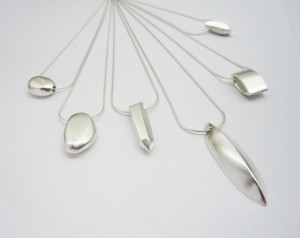You have a jewelry line you enjoy making. Your friends like it. Your family likes it. Your co-workers and neighbors like it. They—and you—are all sure you can make a living selling it.
Can you?
It depends on the price.
“Pricing is very key,” to selling your work, says Seattle jewelry artist Micki Lippe. Pricing also is probably the single most difficult thing jewelry artists struggle with. Is my price too high, or too low? How does it compare to someone else’s price? What can be overlooked is, “Can I earn a living at this price?”
Too often the answer to that question is, “No.”
There is more to a price—especially one that pays a living wage—than replacing materials and adding a modest amount for labor. In addition to materials and labor, jewelry makers must add in overhead (even if you’re working at home in your living room while watching TV) and, if you’re serious about making this your career, profit.
First, let’s talk about why it’s important to develop the right price for your work right from the start.
1.The low price trap
Many jewelry makers, when they start out, make their jewelry as a hobby. They are often happy just to recoup the costs of their materials. If they move into a small, local art market, such as a church bazaar, they may price modestly low. When they branch out to larger art shows, to online marketplaces, or even to their own website, they may try to beat the competition. They may plan to raise their prices as their skill and their market grows. What they may find out, however, is that they have become locked into a low-priced pigeon hole, one that may become difficult to fly out of.
Never rush to compete with the lowest price out there. There are a lot of ramifications of pricing too low, not the least of which will be an inability to make a living at what you do.
Such as…
2. Perception.
An artificially low price lowers the value of your work in the customer’s eyes. Most people have a gut feeling about how much something should cost—especially if they’ve been shopping around. If your price is too low, a customer may assess your skills and product at the same level.
As your career goes on, there will be plenty of people who put your work down or tell you it’s too much money, says Calgary, Alberta, jewelry artist Kari Woo, “You can’t be the first person who undervalues your work,” by pricing it too low. In fact, she says, artists may find that by raising their prices, they begin to sell better.
If you are concerned about the market around you, suggests jewelry artist Megan Auman, rather than looking at the lowest price in the market place look at the highest price for work that is similar to yours. (Take into account the metals, stones, techniques and skills required.) Auman gauges where her work falls in relationship to that work and prices her work appropriately.
3. You may want to wholesale.
Let’s dream big. Suppose that you are discovered at that small, local show or online. What if a gallery, department store, or catalog wants to pick up your line and give you regional or national exposure?
Before you shout, “Yippee!” consider: Wholesale prices are traditionally about half of retail. If your production pieces retail for $150, a gallery will expect to pay you about $75. In addition, retail galleries and boutiques want to hit a price point that appeals to their customers. They may offer less per piece in order to make their price point.
Things are especially tough when working with catalogs, say artists who have worked with these venues. Catalogs usually ask for even deeper discounts because of the high volume they are contracting. More than one artist said catalogs often ask for an additional 15% to 30% discount off wholesale. Even though you get an order for a couple thousand pieces, you may well lose money.
4. You won’t make a living.
Making a living is more than earning your material costs back. It means paying not only your business expenses but your household expenses, insurance, retirement, major home improvements, new cars, your kids’ education, vacations and so on. To do that, you have to consider all your costs—the invisible and ongoing ones as well as the obvious ones. And you have to have a profit included.
Let’s take a look individually at the four parts of a price: materials, labor, overhead, and profit.




